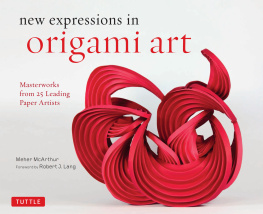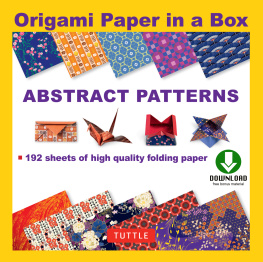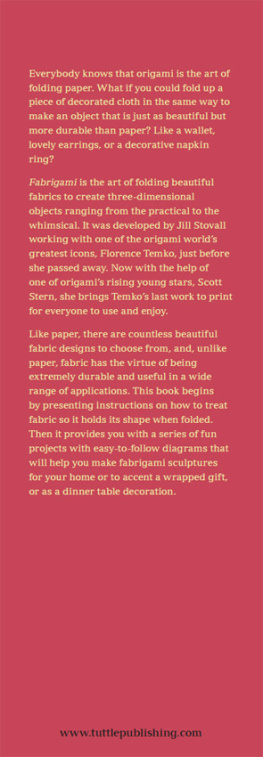Contents
Guide
FOLDING
TECHNIQUES
FOR DESIGNERS
FROM SHEET
TO FORM
PAUL JACKSON

Published in Great Britain by
Laurence King Student & Professional
An imprint of Quercus Editions Ltd
Carmelite House
50 Victoria Embankment
London EC4Y 0DZ
An Hachette UK company
Copyright 2011, 2022 Paul Jackson
The moral right of Paul Jackson to be identified as the author of this work has been asserted in accordance with the Copyright, Designs and Patents Act, 1988.
All rights reserved. No part of this publication may be reproduced or transmitted in any form or by any means, electronic or mechanical, including photocopy, recording, or any information storage and retrieval system, without permission in writing from the publisher.
PB ISBN 978-1-52941-978-8
Ebook ISBN 978-1-52941-977-1
Quercus Editions Ltd hereby exclude all liability to the extent permitted by law for any errors or omissions in this book and for any loss, damage or expense (whether direct or indirect) suffered by a third party relying on any information contained in this book.
Book design by & SMITH
Cover design by Alexandre Coco
Photography by Meidad Suchowolski
Project manager: Rosanna Fairhead
Folding
Techniques
For Designers
From Sheet to Form
Paul Jackson
Second Edition
Laurence King Publishing
An imprint of Quercus Editions Ltd
www.laurenceking.com/student/
Preface
As a teenager, my favourite hobby was origami. Later, as a student of fine art, a steady flow of my original designs was published and I became a very minor player among the small international community of origami creators. Friends who were taking courses in graphic design or industrial design occasionally asked me for origami ideas to help with their projects, and I even did a little teaching.
In 1981, I finished my postgraduate studies in London. Out in the real world and needing a job, I had an idea: maybe courses in art and design in the London area would welcome a short course on origami? I had nothing to lose except the cost of the postage, so I sent a proposal to more than a hundred courses, unsure of the response I would receive.
A few days later the phone started to ring. And ring. Within weeks I was teaching students of fashion design, textile design, graphic design and jewellery design, pleased to be working.
But there was one problem: I had no idea what to teach! Certainly I was skilled at origami, and I had excellent experience in higher education, but my subject had been fine art and I didnt understand what I should teach to students of design. I was entirely ignorant of what design students learnt. Also, my hobbyists knowledge of origami was confined to models that is, representations of flora, fauna, objects and geometric forms. The one thing I did know was that students of art and design didnt need to learn how to make an origami giraffe.
I have always admitted that my first attempts at teaching students of design were terrible. In those early days I did little more than use selections from a list of favourite models. Slowly, though, I began to understand something that now seems very obvious to me, but which at the time required a quantum leap of my imagination namely, that I shouldnt be teaching the students how to make origami models, but instead, should teach them how to fold. It had never previously occurred to me that folding paper was anything other than model-making. To understand that origami could be as much about folding as about models seemed a radical departure. In time, I came to realize that it wasnt radical at all, but a consequence of being unwittingly blinkered brainwashed, even by 15 years of origami practice.
The crucial educational difference was that a model was simply a model perhaps fun to learn, but it didnt teach the students much that they could apply creatively to their design work. By contrast, if folding techniques were taught, they could be used with any number of different materials and adapted to any number of design applications. And when I looked around, I could find examples of folding throughout both the natural and the designed worlds.
That revelation was the genesis of this book.
In the few years following that epiphany, I evolved a series of self-contained mini workshops that introduced a diversity of folding techniques pleating, crumpling, one crease and so on. I would shuffle the choice and content of the workshops to best suit each course. The workshops were usually followed by quick hit and run creative projects.
As word spread, I began to be employed as a consultant by a number of multinational companies, to give workshops on the theory and practice of folding. I also gave workshops to a variety of design practices and to architects, structural engineers and professional bodies. These experiences fed back into my teaching, which in turn fed back into my professional experiences.
By the late 1980s, the final form of my teaching had more or less evolved. I have taught what I came to call Sheet to Form workshops and projects to students of fashion, textiles (surface, print, knit and weave), ceramics, embroidery, product design, industrial design, engineering, architecture, jewellery, graphic design, interior design, environmental design, model-making, packaging, theatre design, fine art, printmaking, foundation courses and probably other courses now forgotten at all educational levels, from my local community college in north London, to the Royal College of Art and colleges in Germany, the US, Israel, Belgium and Canada. To date, Ive taught on more than 150 courses in design in 54 colleges, some regularly for a decade or more, others for just a day.
Wherever Ive taught, Ive always been asked the same question: Is this in a book? My answer was always No! and, frankly, the lack of follow-up material, or any substantial documentation, was an embarrassment to me. Although there are hundreds of origami books, they are all about model-making, of limited use to a design student or professional. My best advice was always to keep carefully the samples made in the workshop and refer to them when working on a project.
So, finallyfinally!I have the opportunity to present in print the most useful of my Sheet to Form workshops. Deciding what to include or exclude, or to emphasize or skim over, has been difficult and time-consuming, and I hope I have made the right choices. I have written more than 30 books about origami and paper crafts, but this is the one I have most wanted to write.
Perhaps, though, it was proper that the book was not written until now. In recent years there has been an upsurge of interest in origami, not only by designers of all disciplines, but also by mathematicians, scientists, educators and others. Origami and folding are very much words of our time, and though the focus will doubtless diminish, the interest and respect will remain. This book, then, is being published at the right time.
I hope that while using this book you will come to share my enthusiasm and love for a subject that I have come to regard simply as a Wholly Good Thing. I feel very privileged that it has not only made me a living, but given me an absorbing and fulfilling life and introduced me to many wonderful people, worldwide.
Paul Jackson
Preface to the Second Edition







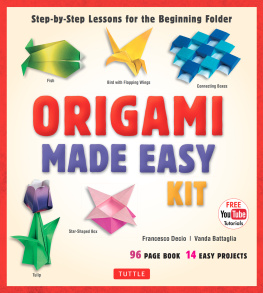

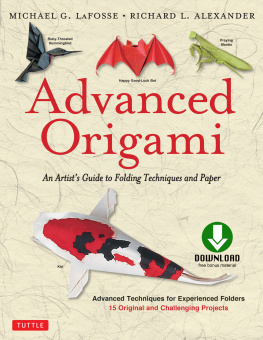
![Marcia Joy Miller - Origami for Busy People: 27 Original On-The-Go Projects [Origami Book, 48 Papers, 27 Projects]](/uploads/posts/book/151502/thumbs/marcia-joy-miller-origami-for-busy-people-27.jpg)
